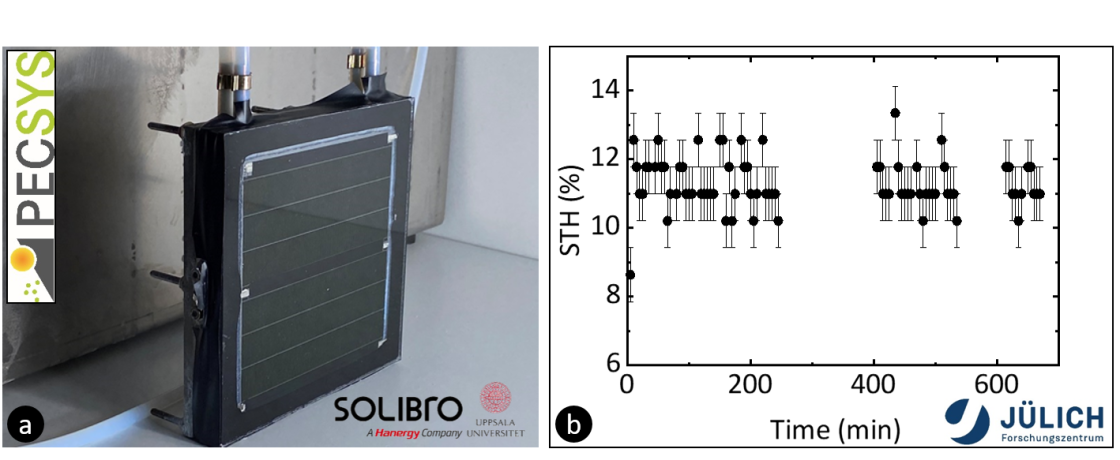Project PECSYS
Specific Objectives
PECSYS specific objectives are to:
- Study and develop devices for integrated PV-EC concepts and scale viable concepts to prototype size > 100 cm².
- Use socio-techno-economic analysis to predict and select concepts with levelised cost of hydrogen production below € 5/kg.
- Scale the prototypes of the less mature but promising technologies to a demonstrator with active area > 10 m².
- Achieve a hydrogen production of 16 g-H2/h from the demonstrator resulting in a STH efficiency of at least 6 %.
- Ensure that the initial demonstrator STH efficiency does not reduce by more than 10 % after six months of continuous operation.
The project is anticipated to increase awareness of the technical and economic benefits of such a system among the general public and manufacturing companies, who are the prospective users and producers, respectively. The results and knowledge acquired from the project would provide an additional alternative for carbon neutral energy generation and improve the competitiveness of European PV and electrolyser manufacturers who would benefit from value added to their products.
Work Programme
WP 1 – Coordination: comprises those activities related to the management of the project including financial, technical, communication and risk management; as well as the quality assurance of its deliverables. [WP leader: Helmholtz-Zentrum Berlin für Materialien und Energie - HZB]
WP2 – Silicon based approach: dedicated to the upscaling of silicon based PV driven electrolyser approach and the improvement of its stability together with WP5. [WP leader: Helmholtz-Zentrum Berlin für Materialien und Energie - HZB]. An example of an integrated device design using the silicon based approach with the related outdoor performance is shown below.

Closeup of a photovoltaic integrated electrolyser made up of a 294 cm² silicon heterojunction minimodule and a liquid alkaline electrolyser with 50 cm² transition metal coated nickel foam electrodes. Hydrogen production rate (b) and solar to hydrogen conversion efficiency ηSTH (c) as a function of the incident solar irradiance G and the PV module temperature TPV in Berlin. More details at: Sustainable Energy Fuels, 2020, 4, 4831; DOI: 10.1039/d0se00921k
WP3 – CIGS based approach: dedicated to the development of higher voltage CIGS materials, development of catalyst modules, and upscaling of the CIGS based PV driven electrolyser approach with non-precious HER and OER catalysts. [WP leader: Uppsala Universitet - UU]. The figure below shows a device concept using the CIGS based approach.

A thermally integrated device made up of a 2×3-cell CuInGaSe photovoltaic module (active area ~ 82.3 cm²) and a FeNiOH (cathode)-FeNiOH (anode)-based alkaline electrolyser with an electrode area of 100 cm2 (a). The solar to hydrogen conversion efficiency (STH) remains above 10 % for more than 1 hour at 1000 W/cm² without active temperature control (b), resulting in an average hydrogen production rate of 5.74 mL/min.
WP4 – Cassette approach: will develop a modular electrolyser consisting of one or several cells connected in series in a ‘cassette design’ to adapt the operating voltage of the EC- to the PV-modules. [WP leader: Consiglio Nazionalle delle Ricerche – CNR]

Demonstration of 730 cm² bifacial silicon hetetojunction PV module directly coupled to a PEM electrolyser (a) in Catania, Italy. Bifacial PV modules provide more power (b) generate more hydrogen (c) and boost the Solar to Hydrogen (STH) conversion efficiency (d) by +13 % compared to monofacial PV modules.
Details at: https://doi.org/10.1016/j.jpowsour.2020.228619
WP5 – Packaging and sealing: dedicated to increase the lifetime of integrated PV-EC devices to ensure the project’s overall objective of more than six month operation with less than 10% degradation. [WP leader: Helmholtz-Zentrum Berlin für Materialien und Energie - HZB]
WP6 – Device simulation / Socio-techno-economic-& life-cycle-analysis: dedicated to the understanding of the system in terms of technology development- and cost-potential. Technology potential will be screened based on band gap and band energies calculations, which will be determined from photosensitivity measurements. A complete socio-techno-economic model based on cost and performance of each essential component will be developed including BoP. [WP leader: Uppsala Universitet - UU]
WP7 – Prototype panel and field tests: dedicated to scale up of the selected device concept to the module size and the actual realization and testing of the 10 m² system including BoP and gas handling. [WP leader: Forschungszentrum Jülich - FZJ]. The current layout of the test field with preliminary measurements is shown in the figure below.

The 10 m² PV-EC demonstrator test field located at Forschungszentrum Jülich, Germany (a). The PEM electrolyser cassette with advanced water supply and no need for auxiliary power, is fixed directly to the back of the PV panels (b). The system generated over 185,000 L hydrogen from April-August 2020 (c) with a solar to hydrogen efficiency exceeding 10 % with stable operation after more than 2500 load cycles (d).
WP8 – Project Exploitation, Dissemination and Communication: dedicated to the installation and maintenance of appropriate dissemination and external communication activities as well as the set-up and follow-up of adequate exploitation activities. [WP leader: Consiglio Nazionalle delle Ricerche – CNR]
